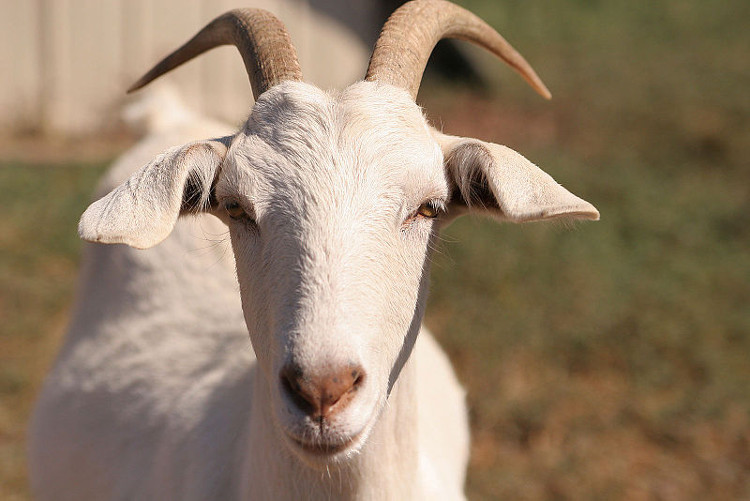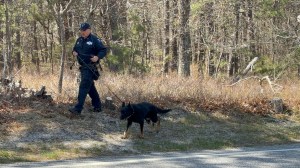The ecosystems of Babylon, Huntington and Islip are all in danger, and few could argue that soldiers returning back home from the war in Afghanistan couldn’t use a de-stressor.
The solution to both issues may very well be a livestock best known for their milk and predisposition to saying “Baaa.”
Several invasive species—non-native flora and fauna that adversely affect habitats—are threatening to wreak ecological havoc, limit biodiversity and overrun the area. Their names are autumn olive and mugwort, and they are responsible for habitat degradation, inflicting diseases upon livestock and depleting indigenous wildlife and tree species.
Ground zero in the battle against these threatening exotics is the 813-acre state-owned Oak Brush Plains State Preserve at Edgewood. In the past, organizations such as the Edgewood Flyers—a model aviator group which helps maintain the preserve—along with the New York State Department of Environmental Conservation (DEC) have employed mechanical machinery and strenuous hand-pulling efforts to expel invasive species from the property.
For the first time on state lands, the DEC is deploying a new strategy to stop this growing threat: goats. Yes, you read that correctly, goats. To be precise, 10 mixed Nubian goats.
The state views these ever-munching mammals as nothing short of game-changers. Why? Well goats, it turns out, absolutely love to eat. Their diet? Vegetation, invasive species.
Targeted grazing, also known as Intensive Rotational Targeted Grazing (IRTG), is an ecologically sound management system used to maintain the escalation of invasive plants with the stationing of grazers, such as goats, sheep and cattle.
Here’s how it works: The animals are rotated between several plots of land at two-to-three day periods. The animals browse—feed on the leaves, shoots and fruits of woody plants in the area—and graze, until most of the vegetation is trimmed down and then they’re herded into a different plot to do the same thing.
The goats will be quartered within a six-acre solar-powered electric fence to prevent their escape and shield them from potential predators. DEC forest rangers and natural resources staff, along with Adopt a Natural Resource groups and the owner of the goats will care for the animals during their five-month stay at the preserve.
Using goats is a natural way to remove invasive species can be highly effective because they typically devour not only the tops of plants but also their root systems, lessening the chance for plants to regenerate, says the agency. Once the goats finish their browsing season, DEC staff will evaluate the results and may attempt to replant the area with native species in the following growing seasons.
“The arrival of these goats gives us a new tool in our arsenal to control invasive species on the property,” said DEC Regional Director Peter A. Scully in a press release announcing their new, hungry weapons. “Hopefully, they will bring a voracious appetite which will soon rid this section of the preserve of these quickly spreading invasive species.”
Dr. Gary Kleppel, a professor of biology at the State University of New York at Albany, is at the forefront of targeted grazing, continuously studying and conducting research on the topic since 2008. Also a proud farm owner, Kleppel tells the Press he wondered about the capacity to restore the habitat with livestock.
“Two things that we didn’t expect was the sheep took out the invasive quickly and efficiently and where they’ve been we saw an increase in species richness,” explains Kleppel. “The biodiversity increased and it was really exciting.”
Species richness is the number of different types of plant species in one place that was once dominated by a single or two species. Goats typically eat three to five pounds of vegetation per day and according to Kleppel, they eat so much of the plant, it can destroy the process of photosynthesis.
“They put so much stress on the plant, the plant can’t get the energy and is basically starving to death,” he says.
The biggest surprise in his studies was the amount of biodiversity in the area after feeding.
“We’re grazing in a place for 12 days and seeing a 50-percent increase in the numbers of plant species,” says Kleppel.
Not only is he continuing his studies, but Dr. Kleppel is also working with the DEC on a pilot project called the New York State Conservation Grazing Program. It will allow young farmers to use their livestock for grazing purposes on state lands.
“We’re looking at 77,000 acres of state land, and if we can find 10 percent that can fit the bill, we could put over 500 farmers to work tomorrow,” he says. “I can see us grazing Brooklyn, Queens, and Long Island, all these places where there’s grasslands.”
Kleppel also believes Hudson Valley may be a prime spot for the grazing plan.
And while the goats put stress on the invasive species, they may actually help to treat stress-related conditions in soldiers returning home from combat. So Kleppel wants to take the program one step further, by allowing returning veterans to participate in it.
“Sometimes it’s better for them to be in a quiet place, like a farm,” he continues. “It’s a healing experience and can get them a possible career.”
U.S. Sen. Kirsten Gillibrand (D) and Congressman Chris Gibson (NY-19) have been contacted by Kleppel about the possibility of veterans using the program for recovery purposes and to potentially develop new skillsets.
Targeted grazing eliminates the need for pesticides and fossil-fuel machinery, making it a win-win for the ecosystem and environmentalists. Adrienne Esposito, executive director of environmental nonprofit Citizens Campaign for the Environment, also agrees it’s a step in the right direction for eco-friendly projects for a community.
“I think it’s an excellent project and there’re no toxins involved,” she tells the Press. “The public is going to love it.”
Funding for this unique strategy was made possible through an Aid to Localities grant obtained by Assemblyman Robert K. Sweeney (D-Lindenhurst).
“Rather than use polluting chemicals, this is a creative, natural way of controlling invasive species that will not be harmful to our groundwater,” he said in a statement.
“Bon Appetit.”



























